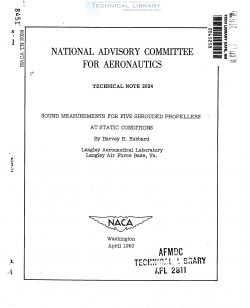naca-tn-2024
- Version
- 63 Downloads
- 1.67 MB File Size
- 1 File Count
- December 14, 2016 Create Date
- December 14, 2016 Last Updated
National Advisory Committee for Aeronautics, Technical Notes - Sound Measurements for Five Shrouded Propellers at Static Conditions

Sound—pressure measurements at static conditions arereported for
five shrouded propellers and are compared with those for an unshrouded
propeller of the same diameter Operating at approximately the same
rotational speed and power.
The maximum total sound pressure produced by a two-blade shrouded
propeller is found to vary approximately from one—half to twice as much as
that for a two—blade unshrouded propeller, depending on whether the flow
at the shroud surface is unseparated or separated, respectively. During
conditions of unseparated flow the higher harmonics of rotational sound
are greatly attenuated, the vortex noise produced is at a minimum, and
the resulting sound is predominantly of low frequency. For the separated
flow condition, all rotational—sound frequencies are reinforced, the
vortex noise is much greater, and an unpleasant high—frequency sound
results.
As is the case with unshrouded propellers, an increased number of
blades and a reduction in tip speed tend to reduce the sound pressures.
The shroud chord is found not to be critical except insofar as the
aerodynamic'considerations are affected. Tip clearances of less than
1 percent of the diameter are found to be satisfactory when sound alone
is considered. In general, if the shroud—propeller unit satisfies aero—
dynamic requirements, good sound characteristics will also be obtained.
The possibility of decreasing the sound and increasing the thrust
of a propeller by means of a shroud has been discussed in reference 1.
An analytical investigation and a series of wind—tunnel tests of a
shrouded propeller were included in reference 2.
Recent static tests of a shrouded propeller (reference 3) have
indicated that approximately twice as much static thrust was obtained
at a given power coefficient as with an unshrouded propeller, chiefly
because the unshrouded propeller was stalled, whereas the shrouded
prepeller was unstalled. During these tests the shroud—propeller unit
was observed to run quietly at times and to be very noisy at other
times. During noisy operation the flow was observed to be Separated
from the inner shroud surface at the leading edge and during quiet
operation the flow was unseparated.
| File | Action |
|---|---|
| naca-tn-2024 Sound Measurements for Five Shrouded Propellers at Static Conditions.pdf | Download |

Comment On This Post